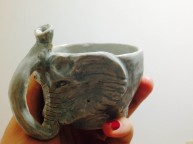This semester for my CIP (Community Involvement Project), I chose a different route than I did last semester by deciding to join an English conversation circle. While it did take me awhile to find out about this circle, I have been able to attend this circle’s events three times thus far (and I intend to go to the group’s next two meetings as well before I leave Japan). The group is open to anybody who wishes to attend, and of course by nature of it being a circle which focuses on English, foreigners are especially more than welcome to attend. While the group does feel somewhat artificially structured in the sense that it has its activities scheduled rather precisely, it is definitely a worthwhile experience. The structure of every meeting starts out with a sort of “speed dating” like part where one row of people stay seated and every three minutes or so the person who one is talking to moves one seat over to talk to the next person. This is a good way to meet people quickly, but always reintroducing oneself can be a bit cumbersome. In addition, if you have started a great conversation with somebody that you would like to continue, you’re out of luck once people have to rotate. If you run out things to talk about during this portion of the meeting, you can always fall back onto the default topic which they provide you (in my experience it was usually something like “your favorite childhood food” or something else often pertaining to one’s childhood). Usually during this part, people often elected to talk about, since I am obviously a foreigner, where I am from, what I am doing in Japan, where I have traveled in Japan, how long I will stay, and any other number of things that come up naturally in the conversation. After the “speed dating” part of the meeting, for the rest of the time, people are given a random number and all split into these randomly assigned groups. There are different prompts and topics to talk about, but this is a fun part to talk to people in a group setting about different things. First everybody introduces themselves one-by-one while the others make comments back about things (I would always mention how I am an Asian studies major and how I really love Lady Gaga, for example). One of the assigned topics I can recall offhand was about a dream we have had while sleeping (which was a great chance for me to show people how weird my dreams are). Another was about games we loved to play as children, for example. At some point, the conversation strays from these assigned topics into a more natural one where you get the chance to better connect with the people you’ve just met. For me, I have a MUCH easier time expressing my real personality when I use English, so I felt like I could really truly be me, and if somebody didn’t understand something, I could always of course explain it to them in Japanese. All in all, through Klexon, I did meet a LOT of very cool people, and I even had one or two people ask for my LINE contact information. Unfortunately, I didn’t have a lot of chances to go to these meetings despite the fact that they were held every Tuesday evening, and as a result, I was disappointed in that I feel like I didn’t make any real friends from this circle. My advice for anybody wishing to join this circle would to be more proactive with that by attending meetings more and also the group’s additional non-meeting events (which I unfortunately was never able to attend). The meetings themselves were certain enjoyable even though the Tuesday evening meeting time forced me to cancel my host family dinner time every Tuesday. One unfortunate thing I thought about the meetings was right when the official meeting time ended, nobody stuck around to talk more outside of meetings which I feel would have been valuable for really making connections with other people. But, at the end of the day, Klexon was a very nice and very convenient circle to join that I would recommend for casual fun and getting to talk to people.
I can’t in all good conscience make any sweeping claims about Japanese culture as a whole from my time at these meetings, but perhaps a few cultural characteristics can be inferred. Particularly, the most noticeable, to me at least, is how structured and regularized this group is. It feels much less like a place to make new friends and much more of a place to get in something of an hour of English practice at the same tightly scheduled time every single week. Meetings start promptly at 7pm every Tuesday evening and end promptly at 8pm. At that time, everybody leaves the room (a different circle has its event immediately after in the same room), and everybody returns on their merry way, nobody stays after to further pursue conversations. It ultimately feels like a less natural and more artificially scheduled and carried out sort of affair. Perhaps this could be a reflection of Japanese people to treat such opportunities as just another time slot to fill versus a time to just relax and talk to new people.

